Charity Youth Hockey Tournament
BUSINESS PLAN LUCKY PUCKS
223 Grand Trunk Street
Cleveland, Ohio 44113
Lucky Pucks is a nonprofit corporation, chartered in Ohio, whose charitable concern is to supply research funds to aid in the search for a cure for spinal cord injuries. Lucky Pucks also is a high school hockey tournament. Its two goals: To fund research using revenues from charitable activities and to standardize and formalize tournament procedures in order that they may be easily reproduced in other cities. This plan was provided by Stephen Kinstler and was compiled in conjunction with the business planning courses of St. Louis University's Entrepreneurship Program.
- EXECUTIVE SUMMARY
- BUSINESS DESCRIPTION
- TARGET MARKET
- THE CHARITY INDUSTRY
- MANAGEMENT
- CORPORATE GOALS & FINANCIALS
EXECUTIVE SUMMARY
Every 35 minutes someone is told that they will never walk again. That works out to be over 10,000 people a year. Lucky Pucks does not believe in the word "never." Unless, it is "never give up."
Lucky Pucks is a charity youth hockey tournament. It was founded in order to fund research to help find a cure for spinal cord injuries (SCI). Despite the alarmingly low amounts of money spent on spinal cord injury research, recent medical advances have projected the timeline to finding a cure at 5-10 years.
If you were to compare government research money spent on SCI research to AIDS research, something amazing occurs. Government spending on SCI research was $17 million dollars in 1994. With 250,000 SCI patients in the U.S., this works out to be $68 per person. Government grants to the National Institute of Health in 1994 to study AIDS research was $1.4 billion. There are now 501,310 reported cases of AIDS in the U.S. This works out to be $2,792.68 per person. President Clinton authorized a grant March 6, 1996 to assist 50,000 AIDS patients so they could afford medicine of $55 million. This works out to $945.45 per person. There exists some disparity in these numbers. The lack of funding for spinal cord injury research may be due to the fact that spinal cord injuries are considered permanent. Likewise, at this time, there is no cure for AIDS.
Lucky Pucks held its inaugural tournament in Cleveland on October 8, 1995. The event attracted an attendance of 6,700 for the entire daylong event. The event raised $25,000 after expenses. The money was given to the Spinal Cord Society to fund research projects, and to St. John's Mercy Hospital to provide advanced patient care. Lucky Pucks appeals to the Cleveland hockey fan, specifically those that attend high school hockey games. Fans tend to fall into three categories: high school students, parents of the players, and youth hockey players. They account for nearly all of the 300 fans that a Mid-States Club Hockey Association game averages for each high school game. The household income for members of this market is above $35,000 a year. In order to raise more research funds, Lucky Pucks must expand. Next year we will include 32 local high school teams. In 1998, we will add seven other cities and hold an eight-city tournament in February of 1998 in Cleveland. In addition, each city will have its own local operation benefiting an area rehabilitation hospital and the Spinal Cord Society. Lucky Pucks will help set up those operations in the other seven cities. Eventually, we will have a tournament in each of the 26 cities that has a National Hockey League franchise. We are setting lofty goals for ourselves, but compared to making the disabled walk again, our goals pale in comparison.
Lucky Pucks has proven that it can be successful. Last year we were able to raise a significant amount of money when only 8 teams were competing. This year we will have 32 teams. The increase in participation of high school teams will provide nearly three times the funds for research over last year's total. In addition to raising research funds, Lucky Pucks is dedicated to raising the level of disability awareness in Cleveland. Just by getting out in the public, the disabled person is able to provide a noticeable presence in the community. We can make a difference. Never? Never heard of the word.
Lucky Pucks: Incorporated January 12, 1995 as a 501(3) "C" corporation. This designation is possible because Lucky Pucks is a nonprofit corporation that is centered on a single event.
Founder and current president: J. B. Buckholtz.
Relevant Statistics:
- There are between 10,000 to 14,000 spinal cord injuries every year.
- 82 percent are men between the ages of 17-24.
- Major causes of injury are automobile accidents, falls, diving accidents, and gunshots.
- Around 52 percent of all spinal cord injuries are quadriplegics, having no leg or hand control.
- Medical costs per year can range from $10,000 a year for a low-level paraplegic, like Mike Utley, to $400,000 a year for a very high-level quadriplegic, like Christopher Reeve.
- There are approximately 250,000 Americans disabled by a spinal cord injury.
Promising research has shown that paralysis is reversible. Reasonable estimates predict a time frame for finding a cure at 5-10 years, with funding of $200 million. Current funding by the government totaled $17 million in 1994. Private funding in that same year was approximately $10 million.
BUSINESS DESCRIPTION
Lucky Pucks is a nonprofit corporation, chartered in Ohio, whose charitable concern is to supply research funds to aid in the search for a cure for spinal cord injuries. Joe Buckholtz founded the organization in 1995 after his son sustained a spinal cord injury. Mr. Buckholtz was alarmed when he learned of the present state of government funding. Currently, the government is spending approximately $17 million a year to aid spinal cord injury research projects. Private funds for research projects for spinal cord injuries were estimated at $10 million in 1994 and should rise slightly in 1995. Many estimates establish a timetable of five years needed to find a cure. Presently, research projects are unable to be run concurrently due to lack of adequate funding.
Lucky Pucks receives a majority of funding from a high school hockey tournament that is held once a year. The event is held at the Sparling Center in Cleveland, Ohio. Volunteers that have various ties to the local hockey community run the tournament. Members of the organizing committee hold various positions in local hockey and athletic organizations, including Fans, Inc., Mid-States Hockey, the referee's association, Monroe Athletic Association, and the Reds Alumni Association. Lucky Pucks has two organizations that are the recipients of their charitable funds. They are St. John's Mercy Hospital in Cleveland and the Spinal Cord Society in Muskegon, Michigan. The former provides care for spinal cord patients and the latter is concerned primarily with finding a cure for spinal cord injury.
The tournament in 1996 will be expanded to include a two-week tournament format at local rinks with the finals at the Sparling Center. Last year's tournament involved only eight teams playing at the Sparling Center. Facility rental was a major expense. In 1996, the facility rental will be lower this year due to the involvement of Cleveland Reds personnel. They have provided Lucky Pucks with increased access to ice time in the Cleveland area at a lower cost. In addition, the tournament will be expanded from the original eight teams, to all varsity high school hockey teams in the Cleveland metropolitan area. Each team is invited to participate in three games at no direct cost to the team. They will, however, be asked to sell $2,500 in tickets. A private donation of $4,500 will be divided among the two top ticket selling teams, $3,000 to the top seller and $1,500 to the second best seller. These organizations can use the money in any way they see fit. As of March 1996, 32 out of 42 teams have committed to play in the tournament to take place in late September, early October of 1996.
Lucky Pucks has a list of corporate sponsors that are vital to its success. KHSR, All-Sports radio, has expressed its interest in becoming the exclusive radio provider for the tournament. In return, they will provide publicity for the tournament with a value at approximately $20,000. The Cleveland Suburban Journals is also a sponsor that provided a series of articles publicizing the event last year. They will once again provide their support. An aspect of the tournament that proved to be lucrative was the auction of sports memorabilia from sports stars, including Brett Hull and Wayne Gretzky. In addition, T-shirts sold at a rather brisk pace, adding to total revenue.
Lucky Pucks has two goals: To fund research using revenues from charitable activities and to standardize and formalize tournament procedures in order that they may be easily reproduced in other cities. By 1997, Lucky Pucks will be expanded to include seven other cities in North America that have a strong amateur hockey program, a progressive rehabilitation center for spinal cord injuries, and, preferably, an NHL franchise hockey team. Currently, there are 26 cities that have franchises in the National Hockey League in the United States and Canada.
TARGET MARKET
Lucky Pucks is a high school hockey tournament. Fans of high school hockey consist primarily of high school students, families of players, and youth hockey players. There are fans that do not fit easily into these categories. They include alumni of the various high schools and fans of the professional hockey team, the Pittsburgh Sharks. This group would also make up part of the audience for the tournament. However, they cannot easily be segmented. In addition, they do not make up a sizable portion of those most likely to see a typical high school hockey team. Fans who attend a high school hockey game can be generally classified into these categories:
Target Market:
High school students: 75 percent Male and 25 percent Female
Age: 14-18
Family income: $35,000 and up
This includes players, siblings and peers.Parents of players: 50 percent Male and 50 percent Female
Age: 35-49
Family income: $35,000 and up
This group can include extended family members also.Youth hockey players: 90 percent Male and 10 percent Female
Age: 7-13
Family income: $35,000 and upOther: 80 percent Male and 20 percent
Female Age: 25-35
Income: $25,000 and up*Other includes high school alumni and hockey fans.
The figures that comprise the target market are approximately 50 percent parents, 30 percent high school students, 10 percent youth hockey players, and 10 percent other. Target market size: 375,000.
Most hockey players, parents of players, and fans of hockey fall into the common societal designation of middle-class.
Total Market
The average Cleveland high school hockey game is viewed by approximately 300 people, according to Mid-States Club Hockey Association, the governing body of high school hockey in the Cleveland area. According to my personal experience, the typical Mid-States player comes from a middle-class background, attends high school at a private school or in a somewhat affluent public school district and has parents with income in excess of $35,000. The high cost of equipment and available ice time is a deterrent to more involvement by children.
Last year when the tournament was held involving the eight invited schools, Lucky Pucks was able to attract 6,700 people for the daylong event. A cursory look around confirmed that the majority of attendees fit within our target market categories. Hockey is indeed strong within the Cleveland metropolitan area. There are currently 42 high school varsity teams, 25 junior varsity teams, 13 youth hockey clubs serving children from the age of 5-17, 2 senior men's leagues, and 15 ice skating rinks. The explosion in the popularity of hockey is most evident in the number of skating rinks opened within the past four years. Community skating rinks were erected in Willow Groves, St. Martins, and South Park, and two private operations were begun in Fairlane and Southhampton. The cost of ice time is between $110 an hour at the Cleveland county rinks of Cuyahoga, Lorain, and Summit to $135 an hour. Operations generally begin at 7:00 A.M. and continue throughout the day until 1:30 A.M. This is year round. Ice is available for rent, but the only times available are usually after 11:00 P.M.
THE CHARITY INDUSTRY
Total contributions to charities in 1994 totaled $129.9 billion. This was up 3.6 percent from 1993. Contributions had been consistently headed downward until that time. Corporate donations, adjusted for inflation, declined by $1 billion from 1989 to 1994, or roughly 0.13 percent annually, says the American Association of Fund Raising Counsel, a New York trade group. The recent increase is due in large part to the stabilization of the economy that has occurred. Coupled with this increase in charitable giving has come an increased competition for charity dollars. Internal Revenue Service figures show that from 1975 to 1990, the nonprofit sector grew from 6 percent of the gross domestic product to 10 percent, while revenues climbed 227 percent—more than four times as fast as the rest of the economy. In addition, corporate donations programs are no longer viewed as just giving cash, but are now considered a vital aspect of a firm's marketing plan. The industry has been characterized by these two major changes.
Corporate downsizing has caused companies to rethink their donation programs and concentrate on those activities that will give them the greatest return. Adjusted for inflation, total corporate giving dipped 2 percent in 1994, to $6.1 billion, says the American Association of Fund Raising Counsel Trust for Philanthropy. That's part of a slide under way since 1987 that has resulted from factors ranging from the 1986 tax reform to greater cost-consciousness. Social responsibility was done previously to make a company's directors feel good. Today, it must make that company look good as well. A new Conference Board report calls this new approach "strategic philanthropy" or "financially sound goodwill." The study surveyed 463U.S. companies and found that companies taking a more businesslike approach to charity reported a better image, increased employee loyalty, and improved customer ties. Causemarketing advocates say such campaigns can meet traditional marketing goals, such as boosting market share, pumping up the sales force, or improving a weak public image, while helping causes the customer cares about. A 1993 survey by Roper Starch Worldwide, sponsored by cause-marketing specialist Cone Communications in Boston, found that 66 percent of 1,981 consumers polled claimed they were likely to switch brands if the purchase supported a cause of concern to them. The effects of strategic gift-giving cannot be ignored. A charity must provide a comprehensive benefits package to attract corporate funds. Corporate social responsibility attracts the most media attention, but corporate donations make up a very small percentage (4.7 percent in 1993) of total giving. This compares to 81.8 percent for private donations and 13.4 percent for government and foundations.
Charity Competition
An increase in the number of charities has led to an increase in the competition for charitable donations. Nearly 60 percent of all nonprofits nationwide have been founded since 1970, and their proliferation has intensified competition for both private donations and dwindling government funds. The private philanthropist is by far the largest giver of charitable funds. In 1993, the corporate world gave a total of $5.92 billion. This pales in comparison to private donations that totaled $102.55 billion that same year. Yet, the fallout in the corporate sector has carried over into personal giving. Today, charities have begun to offer benefits in addition to a feeling of goodwill. A charity has to distinguish itself in order to attract funds.
Lucky Pucks must compete for funds with many charities. They include the Salvation Army, United Way, the March of Dimes, and the Variety Club, to name a few. These competitors are better capitalized, better known, and better supported by the community. Yet, these charities do not address spinal cord injuries or its research. A challenge to Lucky Pucks is the idea that individual oriented spinal cord injury fundraisers present. The challenge is to convince donors that the money does not go to an individual, but to the research cause. The reason the misinterpretation occurs is simple: many people have been asked for money to help defray the medical costs of an individual. Lucky Pucks is the first organization in Cleveland to concentrate on the welfare and recovery of all spinal cord patients through progressive research projects.
Spinal cord injuries require surgery, critical care, and long rehabilitation. Even with insurance, the costs to a family are staggering. In an effort to help defray these costs, many families rely on one-time fundraisers in order to make ends meet. In the area of spinal cord research, there is little fundraising. Most people do not get involved until someone they know is affected. In addition, a spinal cord patient is not likely to become an active member of the community until they have gone through a mourning period. Through personal experience it is normally one year, with additional advances made in the third and fourth years. Some never recover emotionally.
The major challenge to fundraising for research is a lack of understanding and a lack of a strong presence among the injured themselves. In the past, a spinal-cord-injured person had no hope for a recovery. Medical science considered the condition irreversible. This pessimistic outlook is finally changing. People are now realizing that we can eliminate this affliction. But fundraising efforts can be hampered by the injured themselves. An injured person does not return to being the same person they were before the accident. Everything is more difficult. They prefer instead to remain in their homes where things are more accessible. A person will not venture out because of two reasons. First, it is hard to come to terms that the individual needs much more help than they used to. Second, the physical structure of a community is not accessible. Although the Americans with Disabilities Act is meant to eliminate these obstacles, many barriers still exist. To effect change, the disabled must take it upon themselves to establish an identifiable presence in the community.
The lessons of the Americans with Disabilities Act will not last if the changes they have made are not utilized. The cause of AIDS research was helped immensely by the associations that it had. Many high-profile people were victims of AIDS. Even though many of us do not know anyone with AIDS, we are familiar with famous people that have been afflicted. Spinal cord injuries have not affected a large number of well-known people. Recent injuries to the actor Christopher Reeve, football stars Mike Utley and Dennis Byrd, and hockey player Travis Roy have brought spinal cord injuries to the forefront. These four men bring home the devastating effects a spinal cord injury can have. Each one was considered to be in tremendous physical shape. Each one was considered to be in the prime of his life. Each one was injured competing in a sport they loved.
Lucky Pucks is in direct competition with many larger more established charities. We do not have the resources to compete with these organizations on a large scale. Instead, we have established a niche in which to operate. We have the opportunity to establish ourselves as the premier organization to raise funds for spinal cord injuries. Many fundraising activities are done locally with little impact beyond the community. A strong national drive can link each community effort and make a difference in the lives of many. Lucky Pucks faces competition from other smaller charities, such as golf tournaments, church bazaars, etc. Each charity tries to attract funds by associating a reward with the donation, i.e. a round of golf or crafts. Lucky Pucks offers a donor the opportunity to view quality hockey in Cleveland's premier facility, the Sparling Center. The price for tickets to a professional hockey game at the Kiel ranges from $35 to $55.
As a charity, Lucky Pucks brings together high school hockey teams in a forum that did not exist before. For $10 at the Sparling Center or $3 at local venues, people are able to see their favorite team play and evaluate the competition that they will face in the upcoming season. Before the tournament, a fan would have to travel to rinks throughout the city in order to evaluate his team's chances, each time at a cost of three dollars per game and at facilities with vastly different levels of comfort and cleanliness. The event at the Sparling Center will allow a hockey fan to enjoy seven games throughout the day at a cost of $10 for adults and $5 for students. The games prior to the finals will be held at the Johnson Recreation Complex and at the North County Recreation Complex. Each game at these facilities will be at a cost of $3 for admission.
Charitable Operations
Lucky Pucks controls expenses in order to provide the maximum funding possible for research. Eighty percent of revenue exceeding expenses are distributed to St. John's Mercy Hospital and the Spinal Cord Society. In the first three years of operation, high levels of expenses will limit Lucky Pucks. This is due to the initial costs of start-up. Each of the first three years involves substantial expansion. This results in high travel and promotion and travel expense, high phone expense, and high postage cost. In the third year, Lucky Pucks will hold an additional tournament in late February in Cleveland. This will involve eight cities. Lucky Pucks will assist each city in implementing a local "franchise." Each city will be independently operated. To maintain the integrity of the tournament and its goals, representatives of the local Spinal Cord Society chapter will closely monitor each new host city. Each chapter is well established in their area. Lucky Pucks will utilize this strong infrastructure to reach the local spinal cord community and local businesses. The quality of the tournament will be maintained by a strict set of guidelines established by Lucky Pucks and the Cleveland chapter of the Spinal Cord Society. The revenue over expenses that they earn will be divided among a local rehabilitation facility and the Spinal Cord Society home office in Michigan. The additional revenue for the Cleveland chapter of Lucky Pucks will come from hosting the eight-city tournament.
Because the hockey season is not year-round, there is a lull period when there is little exposure for the tournament. Most of our revenue comes in only a few months of each year. Lucky Pucks is implementing an education program to teach the public about disabilities. The effect is twofold. There is a greater understanding of how disabilities affect our lives and Lucky Pucks remains a visible presence year round. This program is provided at no cost to interested groups. There are a variety of speakers available to organizations. The organization can choose the speaker that would be most suitable for its needs.
In order to reduce costs, Lucky Pucks does not maintain central offices. All general meetings are held at Monroe Ice Rink. The director of sales for Lucky Pucks is the facility manager at the rink. All meeting rooms are provided at no cost. Lucky Pucks does maintain a separate mailing address. This is a post office box. Meetings of the board are normally held at a member's household. Lucky Pucks does not intend to have any paid staff positions at this time.
MANAGEMENT
Volunteers control Lucky Pucks. Each position is filled by a qualified volunteer based on prior experience, ties to the hockey community and awareness of the devastating effects of a spinal cord injury. They are president, sales coordinator, volunteer coordinator, tournament coordinator, and executive director.
President: Joseph Buckholtz. Joe is the founder of Lucky Pucks and is the director of manufacturing for Cleveland Shoe Company. Joe is also president of the Hockey Referee's Association in Cleveland and holds a position with the Cleveland chapter of the Spinal Cord Society. He has had vast experience with the Red Cross and is currently involved with setting up a new blood bank is Cleveland. The position of president includes the responsibilities of meeting with prospective sponsors, speaking at local hockey functions about the tournament, and acting as spokesperson at media events.
Sales Coordinator: Dan Simpson. Dan is a journeyman plumber with Ajax Plumbing Company. In addition, he is the facility manager for Monroe Ice Rink. He is responsible for all functions at the rink and coordinating ice times for Monroe Americans Hockey Club, Mid-States High School Hockey Association, and other local clubs. He is responsible for overseeing the sales of tickets for the tournament and is invaluable when it comes to contacts with all the local clubs in the Cleveland area.
Volunteer Coordinator: Betty Singer. Betty was formerly with Fan's Club Inc., a local no-for-profit organization instrumental in bringing the Browns football team to Cleveland. She has extensive experience with the facility operations at the Sparling Center. As volunteer coordinator, she is responsible for organizing the volunteer corps throughout the tournament and for events surrounding the days before and after the tournament.
Tournament Coordinator: George Hill. George is the president of Hill Shoe Company. In addition, he has just recently retired from the Board of Directors for the Mid-States Club Hockey Association. Among his many duties with MSCHA, George was responsible for organizing the championship tournament, the Cleveland Reds Challenge Cup, at the Cleveland Arena and at the Sparling Center. His extensive knowledge of tournament operations is invaluable to the Lucky Pucks charity hockey tournament.
Executive Director: Michael Whistler. Mike is an M.B.A. student at Ohio State University. In addition to working for Whistler Plumbing as a communications coordinator, Mike speaks about disabilities at public functions in elementary schools and for parents' organizations. Mike is responsible for communications that are sent by Lucky Pucks and also maintains Lucky Pucks's databases.
Volunteers
Lucky Pucks is a large operation that would not be successful without the assistance of its volunteers. Volunteers are drawn primarily from in and around the Cleveland hockey community. Some of the notable volunteers:
Bruce Affleck is the director of sales for the Cleveland Reds. He is a former professional hockey player and a current member of the Reds broadcast team on KTRV-TV Channel 20 and with regional sports provider, Top Sports. He acts as a liaison between Lucky Pucks and the Cleveland Reds and their alumni.
Nicholas Bastion is the owner of a local sports merchandise company. He is responsible for Lucky Pucks merchandise, including hats, T-shirts, and sweatshirts.
Kyle Buckholtz is the son of the founder of Lucky Pucks. Kyle acts as a spokesperson for Lucky Pucks.
Additional volunteers:
Announcing and play-by-play: KHSR radio
Referee services: Ohio Ice Hockey Officials Association
Security: At the Sparling Center, Sparling Security Services
At the local rinks, off-duty police or county park rangers
First aid: St. John's Mercy Medical Staff
Support services: volunteers
A nonpaid volunteer fills each position at Lucky Pucks. Each member of the board was selected for their extensive knowledge of the local hockey community and their dedication to eliminating spinal cord injuries. Each volunteer has witnessed the devastating effect that spinal cord injuries can have on the injured and their families. Each volunteer is well aware of the progress that has been made in research in the last few years, and each volunteer is dedicated to finding a cure and making a difference in the lives of many.
CORPORATE GOALS & FINANCIALS
- To at least double the amount of research funds given each year to support spinal cord injury research.
- To expand from one city to eight cities, and possibly each NHL city with the assistance of the NHL.
- To educate the public about disabilities and the effect that they have on the community.
Statement of Revenue, Expenses and Changes in Fund Balance
For the fiscal year ending March 15, 1996
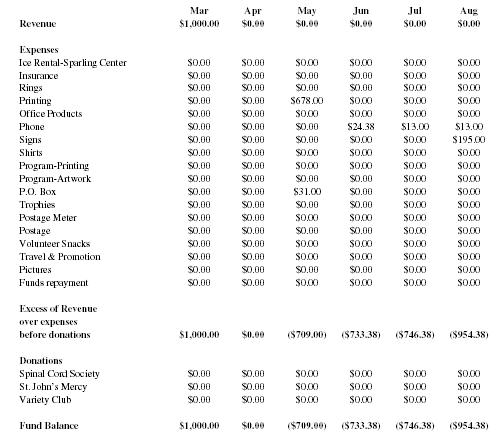
| Revenue | Mar $1,000.00 | Apr $0.00 | May $0.00 | Jun $0.00 | Jul $0.00 | Aug $0.00 |
| Expenses | ||||||
| Ice Rental-Sparling Center | $0.00 | $0.00 | $0.00 | $0.00 | $0.00 | $0.00 |
| Insurance | $0.00 | $0.00 | $0.00 | $0.00 | $0.00 | $0.00 |
| Rings | $0.00 | $0.00 | $0.00 | $0.00 | $0.00 | $0.00 |
| Printing | $0.00 | $0.00 | $678.00 | $0.00 | $0.00 | $0.00 |
| Office Products | $0.00 | $0.00 | $0.00 | $0.00 | $0.00 | $0.00 |
| Phone | $0.00 | $0.00 | $0.00 | $24.38 | $13.00 | $13.00 |
| Signs | $0.00 | $0.00 | $0.00 | $0.00 | $0.00 | $195.00 |
| Shirts | $0.00 | $0.00 | $0.00 | $0.00 | $0.00 | $0.00 |
| Program-Printing | $0.00 | $0.00 | $0.00 | $0.00 | $0.00 | $0.00 |
| Program-Artwork | $0.00 | $0.00 | $0.00 | $0.00 | $0.00 | $0.00 |
| P.O. Box | $0.00 | $0.00 | $31.00 | $0.00 | $0.00 | $0.00 |
| Trophies | $0.00 | $0.00 | $0.00 | $0.00 | $0.00 | $0.00 |
| Postage Meter | $0.00 | $0.00 | $0.00 | $0.00 | $0.00 | $0.00 |
| Postage | $0.00 | $0.00 | $0.00 | $0.00 | $0.00 | $0.00 |
| Volunteer Snacks | $0.00 | $0.00 | $0.00 | $0.00 | $0.00 | $0.00 |
| Travel & Promotion | $0.00 | $0.00 | $0.00 | $0.00 | $0.00 | $0.00 |
| Pictures | $0.00 | $0.00 | $0.00 | $0.00 | $0.00 | $0.00 |
| Funds repayment | $0.00 | $0.00 | $0.00 | $0.00 | $0.00 | $0.00 |
| Excess of Revenue | ||||||
| over expenses | ||||||
| before donations | $1,000.00 | $0.00 | ($709.00) | ($733.38) | ($746.38) | ($954.38) |
| Donations | ||||||
| Spinal Cord Society | $0.00 | $0.00 | $0.00 | $0.00 | $0.00 | $0.00 |
| St. John's Mercy | $0.00 | $0.00 | $0.00 | $0.00 | $0.00 | $0.00 |
| Variety Club | $0.00 | $0.00 | $0.00 | $0.00 | $0.00 | $0.00 |
| Fund Balance | $1,000.00 | $0.00 | ($709.00) | ($733.38) | ($746.38) | ($954.38) |

| Sep | Oct | Nov | Dec | Jan | Feb |
| $13,434.96 | $53,739.83 | $0.00 | $0.00 | $0.00 | $0.00 |
| $0.00 | $31,020.93 | $0.00 | $0.00 | $0.00 | $0.00 |
| $0.00 | $1,575.00 | $0.00 | $0.00 | $0.00 | $0.00 |
| $0.00 | $0.00 | $0.00 | $1,725.00 | $0.00 | $0.00 |
| $200.86 | $0.00 | $0.00 | $0.00 | $0.00 | $260.00 |
| $1,383.24 | $0.00 | $0.00 | $0.00 | $0.00 | $0.00 |
| $13.00 | $13.00 | $13.00 | $13.00 | $13.00 | $13.00 |
| $0.00 | $0.00 | $0.00 | $0.00 | $0.00 | $0.00 |
| $0.00 | $890.28 | $0.00 | $0.00 | $0.00 | $0.00 |
| $0.00 | $1,000.00 | $0.00 | $0.00 | $0.00 | $0.00 |
| $0.00 | $800.00 | $0.00 | $0.00 | $0.00 | $0.00 |
| $0.00 | $0.00 | $58.00 | $0.00 | $0.00 | $0.00 |
| $0.00 | $298.00 | $0.00 | $0.00 | $0.00 | $0.00 |
| $0.00 | $0.00 | $0.00 | $128.00 | $0.00 | $127.47 |
| $0.00 | $0.00 | $267.74 | $0.00 | $0.00 | $0.00 |
| $0.00 | $128.57 | $0.00 | $0.00 | $0.00 | $0.00 |
| $0.00 | $0.00 | $0.00 | $0.00 | $300.00 | $326.31 |
| $0.00 | $0.00 | $230.64 | $0.00 | $0.00 | $0.00 |
| $1,000.00 | $0.00 | $0.00 | $0.00 | $0.00 | $0.00 |
| $10,883.48 | $28,897.53 | $25,422.37 | $6,212.15 | $5,899.15 | $5,172.37 |
| $0.00 | $0.00 | $10,000.00 | $0.00 | $0.00 | $0.00 |
| $0.00 | $0.00 | $10,000.00 | $0.00 | $0.00 | $0.00 |
| $0.00 | $0.00 | $250.00 | $0.00 | $0.00 | $0.00 |
| $10,883.48 | $28,897.53 | $8,078.15 | $6,212.15 | $5,899.15 | $5,172.37 |
Statement of Revenue, Expenses and Changes in Fund Balance
For the fiscal year ending March 15, 1996
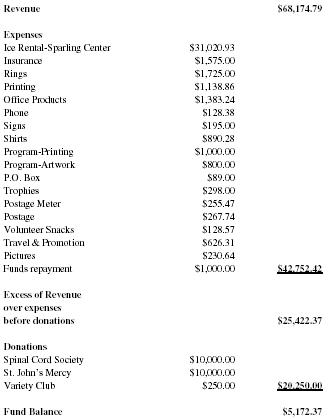
| Revenue | $68,174.79 | |
| Expenses | ||
| Ice Rental-Sparling Center | $31,020.93 | |
| Insurance | $1,575.00 | |
| Rings | $1,725.00 | |
| Printing | $1,138.86 | |
| Office Products | $1,383.24 | |
| Phone | $128.38 | |
| Signs | $195.00 | |
| Shirts | $890.28 | |
| Program-Printing | $1,000.00 | |
| Program-Artwork | $800.00 | |
| P.O. Box | $89.00 | |
| Trophies | $298.00 | |
| Postage Meter | $255.47 | |
| Postage | $267.74 | |
| Volunteer Snacks | $128.57 | |
| Travel & Promotion | $626.31 | |
| Pictures | $230.64 | |
| Funds repayment | $1,000.00 | $42,752.42 |
| Excess of Revenue | ||
| over expenses | ||
| before donations | $25,422.37 | |
| Donations | ||
| Spinal Cord Society | $10,000.00 | |
| St. John's Mercy | $10,000.00 | |
| Variety Club | $250.00 | $20,250.00 |
| Fund Balance | $5,172.37 |
Balance Sheet
March 15, 1996
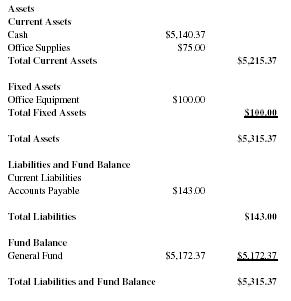
| Assets | ||
| Current Assets | ||
| Cash | $5,140.37 | |
| Office Supplies | $75.00 | |
| Total Current Assets | $5,215.37 | |
| Fixed Assets | ||
| Office Equipment | $100.00 | |
| Total Fixed Assets | $100.00 | |
| Total Assets | $5,315.37 | |
| Liabilities and Fund Balance | ||
| Current Liabilities | ||
| Accounts Payable | $143.00 | |
| Total Liabilities | $143.00 | |
| Fund Balance | ||
| General Fund | $5,172.37 | $5,172.37 |
| Total Liabilities and Fund Balance | $5,315.37 |
Notes to Financial Statements Year 1
Notes for Statement of Revenue, Expenses and Change in Fund Balance, Year 1.
Revenue
- Initial revenue in March of 1995 was a $1,000 advance by Joseph Buckholtz
- Revenue only occurred in September and October
-
Components of revenue:
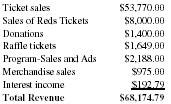
Ticket sales $53,770.00 Sales of Reds Tickets $8,000.00 Donations $1,400.00 Raffle tickets $1,649.00 Program-Sales and Ads $2,188.00 Merchandise sales $975.00 Interest income $192.79 Total Revenue $68,174.79 - Raffle ticket sales are for three Brett Hull autographed hockey sticks
- Merchandise sales include T-shirts and sweatshirts
- Program sales includes purchase price and ad revenue
- Reds ticket sales were the result of a Reds' donation of tickets for three exhibition games at the beginning of the season for sale by Lucky Pucks
- Interest is calculated on monthly balance at approximately 3.75 percent annual interest
Expenses
- Postage was paid only in November. The owner of Cleveland Shoe Company deferred the expense until after the tournament.
- Travel and Promotion include a Redliners Banquet (Cleveland Reds Booster Club) and the Mid-States Club Hockey Association Championship Tournament and Dinner.
- Rings expense is for the purchase of championship rings for the winning team.
- Insurance costs are for the one day event and do not carry over into the next year.
Notes to the Statement of Cash Flows
Disbursements
- Donations to charity include $10,000 to St. John's Mercy Hospital, $10,000 to the Spinal Cord Society, and $250 to the Variety Club.
Notes to the Balance Sheet
Fixed Assets
- Office equipment is a fax machine. Depreciation is allocated for one year. This is due to the rapid obsolescence of electronic equipment and low salvage costs.
Description of Cash Flows
In year 1, Lucky Pucks was a one-day tournament involving eight high school hockey teams. The event was moderately successful and showed much promise for the next year.
Statement of Revenue, Expenses and Change in Fund Balance
For the year ending March 15, 1997
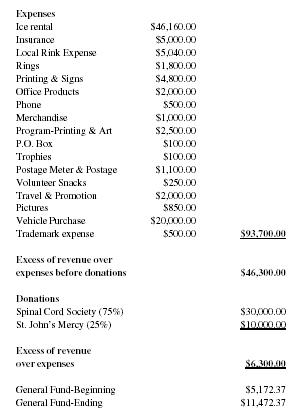
| Revenue | $140,000.00 | |
| Expenses | ||
| Ice rental | $46,160.00 | |
| Insurance | $5,000.00 | |
| Local Rink Expense | $5,040.00 | |
| Rings | $1,800.00 | |
| Printing & Signs | $4,800.00 | |
| Office Products | $2,000.00 | |
| Phone | $500.00 | |
| Merchandise | $1,000.00 | |
| Program-Printing & Art | $2,500.00 | |
| P.O. Box | $100.00 | |
| Trophies | $100.00 | |
| Postage Meter & Postage | $1,100.00 | |
| Volunteer Snacks | $250.00 | |
| Travel & Promotion | $2,000.00 | |
| Pictures | $850.00 | |
| Vehicle Purchase | $20,000.00 | |
| Trademark expense | $500.00 | $93,700.00 |
| Excess of revenue over | ||
| expenses before donations | $46,300.00 | |
| Donations | ||
| Spinal Cord Society (75%) | $30,000.00 | |
| St. John's Mercy (25%) | $10,000.00 | |
| Excess of revenue | ||
| over expenses | $6,300.00 | |
| General Fund-Beginning | $5,172.37 | |
| General Fund-Ending | $11,472.37 |
Balance Sheet
Year 2
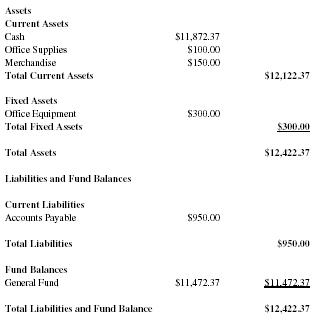
| Assets | ||
| Current Assets | ||
| Cash | $11,872.37 | |
| Office Supplies | $100.00 | |
| Merchandise | $150.00 | |
| Total Current Assets | $12,122.37 | |
| Fixed Assets | ||
| Office Equipment | $300.00 | |
| Total Fixed Assets | $300.00 | |
| Total Assets | $12,422.37 | |
| Liabilities and Fund Balances | ||
| Current Liabilities | ||
| Accounts Payable | $950.00 | |
| Total Liabilities | $950.00 | |
| Fund Balances | ||
| General Fund | $11,472.37 | $11,472.37 |
| Total Liabilities and Fund Balance | $12,422.37 |
Notes to Financial Statements Year 2
Notes for Statement of Revenue, Expenses and Change in Fund Balance.
Revenue
- Revenue consists of the one-day finals at the Sparling Center and the two-week tournament beforehand.
-
Components of revenue:
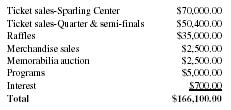
Ticket sales-Sparling Center $70,000.00 Ticket sales-Quarter & semi-finals $50,400.00 Raffles $35,000.00 Merchandise sales $2,500.00 Memorabilia auction $2,500.00 Programs $5,000.00 Interest $700.00 Total $166,100.00 -
Revenue from the Sparling Center event is based on the target sales
level for each high school. This is $2,500.
32 teams @ $2,500 each = $80,000 - $10,000 for sales allowances = $70,000 -
Revenue from quarterfinals and semi-finals is based on the average
attendance at a high school hockey game multiplied by the number of
games, 56.
56 games @ 300 people per game @ $3 per game attendance = $50,400 - Raffles are for vehicles to be given away. Sales for one raffle will take place before the tournament. Sales will be limited to 250 tickets at a cost of $100 each. The second raffle will have sales starting before the tournament lasting the duration of the tournament. Each ticket will cost $1.00. Expected number of sales is 10,000.
- Merchandise includes T-shirts, sweatshirts, and hats.
- Program revenue includes the cost of the program and ad revenue.
- Interest income is calculated on the monthly fund balance at approximately 4 percent annual interest.
Expenses
- Insurance needs are increased due to the expanded tournament size.
- Local rink expense includes scorekeepers, ticket takers, additional security, and incidentals.
- Increase in phone expense is the result of long distance calls to eight prospective Lucky Pucks expansion cities and long distance calls resulting from travel.
- Trophy expense is lower because only a nameplate will be attached instead of purchasing new trophies.
- Travel and promotion are higher due to a regional hockey event in Colorado Springs.
- Vehicle purchase is for the prizes for the raffle. The vehicle will have to be purchased, but at a substantially lower price from the dealer.
- Donations are no longer equally divided by the two charities. At the request of St. John's Mercy, percentages are shifted in order to provide more money for research. The Spinal Cord Society is to receive around 75 percent and St. John's Mercy Hospital is to receive around 25 percent.
Notes to the Statement of Cash Flows
Disbursements
- Donations reflect the change in allotment at the request of St. John's Mercy.
- Travel and promotion increased due to trip to USA Hockey (national amateur hockey association) meeting in Colorado.
Notes to the Balance Sheet
Fixed Assets
- Office equipment is a fax machine and copier. Depreciation is allocated for one year. This is due to the rapid obsolescence of electronic equipment and low salvage cost.
Description of Cash Flows
In year two, Lucky Pucks will be expanded to 32 teams. Thirty-two is the number of teams that elected to participate out of a total of 42 possible teams. Additional cash flows will be experienced because the expanded format will include elimination games at local rinks prior to the one-day event at the Sparling Center.
Break-even Analysis-Facility Rental
Year 2
Quarter & semi-final games:
Ice Rental
- 32 teams requiring 56 sessions @ $110 each session = $6,160 cost for ice rental at local ice rinks
Cost per game of scorekeepers, ticket-takers, and security = $90 a game
- $90 per game (56 games) = $5,040
Attendance needed each game to break even
- $11,200 total cost / 56 games / $3 per person = 67 persons needed per game
Break-even point for local rink attendance = 67 people per game
Average attendance per high school game according to the MSCHA= 300
Sparling Center
Ice Rental at the Sparling Center
- Cost for rental of Sparling Center = $40,000
- Average ticket price = $7.50
- Break-even attendance $40,000 / $7.50 = 5,333 people per game
Break-even attendance for the Sparling Center = 5,333 people per game
Attendance last year for the entire day was 6,700.
Statement of Revenue, Expenses and Change in Fund Balance
For the year 3 ending March 15, 1998
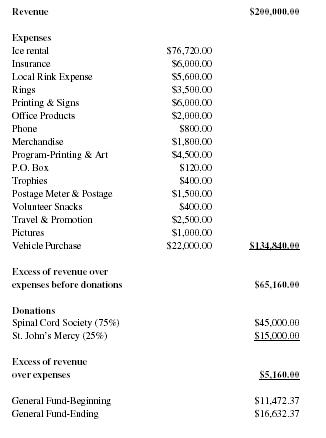
| Revenue | $200,000.00 | |
| Expenses | ||
| Ice rental | $76,720.00 | |
| Insurance | $6,000.00 | |
| Local Rink Expense | $5,600.00 | |
| Rings | $3,500.00 | |
| Printing & Signs | $6,000.00 | |
| Office Products | $2,000.00 | |
| Phone | $800.00 | |
| Merchandise | $1,800.00 | |
| Program-Printing & Art | $4,500.00 | |
| P.O. Box | $120.00 | |
| Trophies | $400.00 | |
| Postage Meter & Postage | $1,500.00 | |
| Volunteer Snacks | $400.00 | |
| Travel & Promotion | $2,500.00 | |
| Pictures | $1,000.00 | |
| Vehicle Purchase | $22,000.00 | $134,840.00 |
| Excess of revenue over | ||
| expenses before donations | $65,160.00 | |
| Donations | ||
| Spinal Cord Society (75%) | $45,000.00 | |
| St. John's Mercy (25%) | $15,000.00 | |
| Excess of revenue | ||
| over expenses | $5,160.00 | |
| General Fund-Beginning | $11,472.37 | |
| General Fund-Ending | $16,632.37 |
Balance Sheet
Year 3
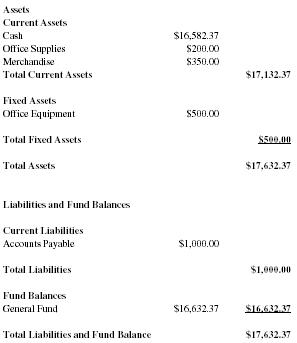
| Assets | ||
| Current Assets | ||
| Cash | $16,582.37 | |
| Office Supplies | $200.00 | |
| Merchandise | $350.00 | |
| Total Current Assets | $17,132.37 | |
| Fixed Assets | ||
| Office Equipment | $500.00 | |
| Total Fixed Assets | $500.00 | |
| Total Assets | $17,632.37 | |
| Liabilities and Fund Balances | ||
| Current Liabilities | ||
| Accounts Payable | $1,000.00 | |
| Total Liabilities | $1,000.00 | |
| Fund Balances | ||
| General Fund | $16,632.37 | $16,632.37 |
| Total Liabilities and Fund Balance | $17,632.37 |
Notes to Financial Statements Year 3
Notes for Statement of Revenue, Expenses and Change in Fund Balance.
Revenue
- Revenue consists of the two-week tournament beforehand, the one-day finals at the Sparling Center and the eight-city tournament in February of 1998.
-
Components of revenue:
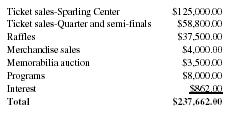
Ticket sales-Sparling Center $125,000.00 Ticket sales-Quarter and semi-finals $58,800.00 Raffles $37,500.00 Merchandise sales $4,000.00 Memorabilia auction $3,500.00 Programs $8,000.00 Interest $862.00 Total $237,662.00 - Ticket sales at the Sparling Center events are split between the two events. The Cleveland tournament will raise $75,000, a $5,000 increase from last year.
The regional tournament in February will raise $50,000. This is based on original tournament figures.
- Quarter and semi-final ticket sales are based on the participation of 32 teams with an average attendance of 350 people per game.
- Merchandise sales will see an increase due to the session in February.
- Memorabilia will increase due to the February tournament.
- Program sales will be expanded to cover two separate programs.
- Interest is based on a 4 percent annual interest rate.
Expenses
- Ice rental includes an additional day at the Sparling Center.
- Increase in phone expense is the result of long distance calls to eight Lucky Pucks expansion cities and long distance calls resulting from travel.
- Trophy expense is higher because of purchasing new trophies for the eight-city tournament.
- Travel and promotion are higher due to trips to two regional hockey events, one in Chicago and one in Colorado Springs and to the eight cities to assist in starting their own tournament.
- Vehicle purchase is for the prizes for the raffle. The vehicle will have to be purchased, but at a substantially lower price from the dealer, the increased cost is due to inflation.
- Donations are no longer equally divided by the two charities. At the request of St. John's Mercy, percentages are shifted in order to provide more money for research.
Notes to the Statement of Cash Flows
Disbursements
- Travel and promotion in April increased for Chicago Showcase Hockey Tournament, a national event involving high school hockey.
- Travel and promotion increased due to trip to USA Hockey (national amateur hockey association) meeting in Colorado in July.
- Travel and promotion is substantially higher due to travel between the participating cities.
Notes to the Balance Sheet
Fixed Assets
- Office equipment is for a copier and replacing a fax machine. Depreciation is allocated for one year. This is due to the rapid obsolescence of electronic equipment and low salvage cost.
Description of Cash Flows
In year 3, Lucky Pucks plans to expand to seven other cities. Each city will run a Lucky Pucks independent of the others. Our organization will help each city organize their event, but each city will be able to format the tournament to best suit the needs of their city. The extra cash flow in February is the result of a regional tournament being played in Cleveland involving the victors in each city vying for the national crown.
Break-even Analysis-Facility Rental
Year 3
Quarter & semi-final games:
Ice Rental
- 32 teams requiring 56 sessions @ $120 each session = $6,720 cost for ice rental at local ice rinks
Cost per game of scorekeepers, ticket takers, security $100 a game
- $100 a game (56 games) = $5,600
Attendance needed each game to break-even
- $12,320 total cost / 56 games / $3 per person = 74 persons needed per game
Break-even point for local rink attendance = 74 people per game
Average attendance per high school game according to the MSCHA= 300
Sparling Center
Ice Rental at the Sparling Center—Cleveland Tournament
- Cost for rental of Sparling Center = $40,000
- Average ticket price = $7.50
- Break-even attendance = $40,000 / $7.50 = 5,333 people per game
Break-even attendance for the Sparling Center = 5,333 people per game
Attendance for the first year for the entire day was 6,700
Ice Rental at the Sparling Center—Regional Tournament
- Cost for rental of Sparling Center = $30,000
- Average ticket price = $7.50
- Break-even attendance $30,000 / $7.50 = 4,000 people per game
Preliminary Expansion Plans
In year 3, Lucky Pucks will expand to eight cities, including Cleveland. Each city will, with the guidance of Lucky Pucks, establish their own charitable tournament. Each city will be independent of each other. This will allow the city to tailor the tournament to best meet the needs of the city. The overall impact on Lucky Pucks—Cleveland will be twofold. One, travel and correspondence expense will be abnormally high as each city begins establishing the tournament. Second, revenue for Lucky Pucks—Cleveland will be augmented as a result of an additional tournament being held in Cleveland involving the winners of the tournament in each city. This event will have a national flavor. Currently, no high school hockey association is involved in a national tournament. For instance, the Mid-States High School Hockey Association in Cleveland has a championship tournament each year. Yet, it cannot be considered a state tournament because they do not include high school teams from other cities, if they even exist. In addition, there are teams from Illinois in Mid-States. ESPN television has expressed an interest in televising a tournament that will involve teams from different cities. The expansion will involve these seven cities:

| Boston | Detroit |
| Chicago | Philadelphia |
| Cleveland | Pittsburgh |
| Denver |
Each city was selected after meeting the following criteria:
- Strength of amateur hockey program in the area
- Strength and support of the professional hockey team in the area
- Regional location in order to keep travel costs low
- Prominence of a progressive rehabilitation hospital in the area
- Strength of a Spinal Cord Society chapter in the city
The ultimate goal is to have a tournament in each National Hockey League city. There are currently 26 teams. As of this date, the National Hockey League does not have a league-wide charity to sponsor. The NHL has stated that Lucky Pucks must prove themselves as a viable charity before they will consider us as a league-wide charity. Hence, there is a need to expand to eight total cities. The commissioner of the NHL was formerly with the National Basketball Association. During his tenure, the NBA established a direct link to the youth involved in basketball. They did this by sponsoring local tournaments and starting a nationwide stay-in-school program. Mr. Soule, the NHL commissioner, is considering Lucky Pucks as a possible avenue to reach the youth and the hockey community. It is with this goal in mind that Lucky Pucks will operate. According to the American Paralysis Association, spinal cord injuries can be eliminated if the level of funding reaches $200 million dollars. With this amount of funding, they predict a cure in five years. It is paramount that Lucky Pucks be instrumental in this drive. We can make a difference. A cure for spinal cord injuries is a definite possibility. No goal is too high for our organization, we have come so far, and we just need to reach a little higher.
How will Lucky Pucks control the integrity of the tournament after expansion?
The key to maintaining sufficient control over the operations in other cities is to use the existing infrastructure of the city's chapter of the Spinal Cord Society. Lucky Pucks will work with the local chapter in helping to set up the tournament. In addition, a representative from Lucky Pucks will be present to oversee the operations of the tournament and aid in the collecting of proceeds from the tournament. The regional structure of the tournament will reduce travel expenses. Lucky Pucks is looking for people that have a personal involvement in the disabled community. This is where the Spinal Cord Society affiliation will prove most helpful. Individuals must be trustworthy, compassionate, and visionary. These individuals will work with Lucky Pucks in establishing and operating their own tournament. In addition to these individuals, the Cleveland Reds will help Lucky Pucks in creating a relationship with the local hockey franchise and the hockey community in the expansion city.
Where does my money go?
In the first year, thirty percent of the funds raised by the tournament were given to spinal cord injury research. The high expenses are due to the fact that this was the inaugural tournament. Lucky Pucks does not plan to maintain that ratio. The percentage in Year 2 is 39 percent and Year 3 is 40 percent. The goal of Lucky Pucks is to return 75 percent of its revenue to research projects and hospitals after expansion is complete. Years 1 to 3 are substantially lower than the target goal. Many expenses are abnormally high in these years because of the expense associated with expansion. Yet, the ratios for years two and three can be significantly improved if the event draws more than the conservative estimates and if the major expenses are subsidized by corporate underwriting.
Who will get the money that is raised by Lucky Pucks?
The bulk of the money raised by Lucky Pucks will be given to the Spinal Cord Society to fund research projects. They have a valuable link to the research community and will be able to best maximize the research dollar. The remaining funds will go to a hospital in the expansion city. These funds will be used for progressive patient care and for purchase of rehabilitation equipment. Some of the proceeds will be used to attract the more successful programs of rehabilitation to the hospital.
Why not give all the money to the Spinal Cord Society?
Lucky Pucks's goal in each city is to establish a tie between the tournament and the community. By assisting in local programs, each new city's tournament will have an impact within the community. In addition, Lucky Pucks needs to be recognized as making a difference, within the area of spinal cord injury research and within the community itself. The money for local programs will be used to fund research projects within the community. Currently, there are commercially available products to aid in SCI care. Three programs that are receiving national attention are the Ergis Bike and the ParaStep program. Of the two, only the Ergis Bike is available in Cleveland. The Ergis Bike aids in the maintaining of muscle mass and range of motion below the injury level. The drawback is that the bike is expensive to operate and very few insurance companies will pay for the service. Local funds can be used to subsidize an SCI patient's medical bills. Second, the ParaStep system uses electrical stimulation of muscle tissue to facilitate lower level movement. An SCI patient is hooked up to the device and the muscles are electrically stimulated to expand and contract. The project is very expensive and costly to operate. The program is not readily available in the Cleveland area and use of the system would require travel to the nearest site in Columbus, Ohio. Although this seems to be a short drive away, coordinating a trip for a SCI patient can be very daunting. The third possible program is called biofeedback. Sensors are attached to muscles below the injury level and the patient is told to try and move these muscles. The sensors register any muscle signal that is sent by the brain. By repetition, a patient is able to learn how to access these muscles and strengthen them. Improvements can be made in the functional levels of SCI patients and help increase their level of independence. This system is also beneficial to stroke patients in learning how to regain their lost functions. By helping fund these types of programs, Lucky Pucks will create a vital link to the disabled community, and to the community as a whole, and show donors the change that their contribution is helping to make.
How much money does Lucky Pucks need?
Lucky Pucks would like to become a large contributor in the area of spinal cord injury research. To do so, Lucky Pucks must limit major expenditures. Currently, the largest expense—ice time—is in need of corporate underwriting. Reducing this expenditure would result in a larger margin between revenue and expenses. The difference would be reflected in a larger contribution to spinal cord research. Current expenses that are subsidized by corporate support are primarily in the area of media and publicity. Other subsidized expenses can be found in the area of accounting services, legal work, and tournament operations.
How much does spinal cord injury research need?
According to various estimates, mainly from the American Paralysis Association, SCI can be cured within five years if the funding is in place. Consensus opinion places the need for funding at around $200 million. Current funding is well below that figure. In fact, many research projects are unable to run concurrent projects due to the lack of sufficient funding.
Comment about this article, ask questions, or add new information about this topic: